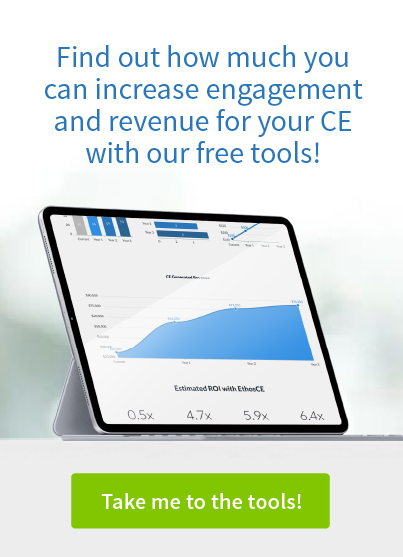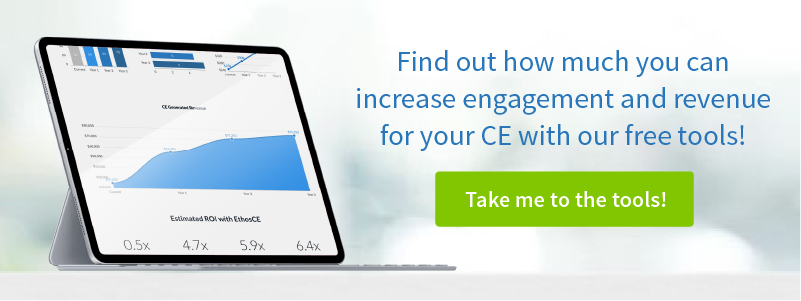How to Make Your CME Mobile Friendly (Accredited Courses)
For many learners, the ability to complete activities on multiple screens is a prerequisite to choosing a CME program. However, creating a CME mobile-friendly LMS is a complicated exercise that requires a team of web developers with expertise in instructional design. Not surprisingly, many organizations simply don’t have the time or resources to staff a mobile web development team in-house. If you’re a CE coordinator facing the challenge of balancing content management and website usability, we want to show you a few simple ways to make a CME mobile-friendly website.
First, let’s define our terms.
What is a CME Mobile-Friendly Website?
“Responsive” is a term that web designers use to describe a mobile-friendly website. This type of site “responds” to the capabilities of the browser and device that it is displayed on and adjusts the page content accordingly. Regardless of the browser or type of device that your members use to reach your website, if it’s responsive, they will find a display that has been tailored to give them the best possible viewing experience.
Pulling that off will require you to find a designer who understands the complex codebases used by modern browsers and mobile devices. They will also have to create a website that displays correctly on various generations of different mobile devices—for example, the iPhone 7 and the iPhone 10. It also needs to be touch-friendly—meaning that the website works as well with touch-screens as it does regular keypads.
If you aren’t using a website design that was developed by a company such as EthosCE—one that specializes in medical associations and CME websites—you’ll have to manage this in-house. Your biggest challenge, however, will be making sure that easy access to your educational content remains the focus of a streamlined, CME mobile-friendly website.
The Challenges of Balancing Content Management and UI Usability
As a CME provider, you’ll know that the quality of your LMS will either enhance or diminish the impact of your educational programming. That’s because a website that is difficult to access or to view on different devices interrupts your members’ CME experience. They’ll have less time (and, perhaps, patience) to participate in activities if they’re met with a usability roadblock before they’ve even started.
The challenges of balancing content management and user-interface (UI) usability can be intimidating. If you build your website for a desktop, you may have pages that are long and rich with content. But what about learners using mobile devices? If they have to scroll endlessly—or worse—find pages cut off and inaccessible on their small screen, then they’re excluded from the full benefits of your program. If you’re going the DIY route, rather than using a third-party platform that specializes in this sort of design for medical associations, here are a few guidelines to follow:
Focus on “Lean” Development
“Lean” design has been around for a few years. It’s defined as design that focuses on the essentials, rather than allowing style to overwhelm function. An example would be changing the UI of an educational website to highlight content and simple navigation, rather than wasting valuable space on images that distract from the login, menu, and self-service section. Make sure your design optimizes access to the most important tasks—login, activities launch, activities progress data, and payment.
Mobile-Friendly Design is Touch-Friendly
Your mobile user with a touchscreen shouldn’t have to squint or spend a lot of time scrolling to find a navigation bar or login. Make buttons large enough that they stand out, and be sure that links can be seen easily. Use menus sparingly and make them as simple as possible. Dropdown menus can save space on a page and involve less clicking than other designs. However, don’t overload users’ screens with too many menus of this kind in an attempt to make all of your content links fit on one page. Use icons where possible instead of text to manage simple navigational directions—this saves time for mobile users and makes it less likely they’ll need to zoom in to read small font.
Rethink Instructional Design
Every learner should have the same quality of educational experience regardless of the device that they are using. That means you’ll have to identify the design elements in your LMS which may slow your mobile users’ participation in an activity. These elements might include a logout button that displays only at the top of a page’s navigation bar, and a footer that doesn’t feature a button that will bring the reader quickly back up to the menu, without scrolling. An activity that includes a video which doesn’t offer an option to pause and return to the same page easily can also hinder the mobile learning experience. Users unable to stream long videos because of a slow wifi connection will unnecessarily spend extra time trying to finish your activity.
Make Images Light and Animations Scarce
As important as visuals can be for learner knowledge retention, too much of a good thing, in this case, can sabotage your learners’ engagement. High-resolution images and trendy page transition animations might be stunning, but they can create a slew of problems when they appear on a mobile screen. Some animations (such as advanced CSS animations) can’t be viewed on certain browsers, while others (like Flash) may behave in vastly different ways depending on the generation of the user’s device.
Finding a Mobile-Friendly LMS Service
If it seems like creating a CME mobile-friendly website is a formidable challenge, even for experienced web designers, you’d be right. Just like medical professionals, web developers must keep up with the latest technologies and frequent changes in best practice standards. Finding the right web designer or firm can be difficult. If you aren’t a programmer, it will be virtually impossible to determine if the website that you’ve purchased will still work properly when the next browser upgrade occurs.
The design of your website can support—or work against—the positive impact of your CME programming. At EthosCE, we offer web development services which focus on the needs of CME providers and their learners. We provide an LMS platform that works seamlessly on desktop, laptop, and mobile devices. Connect with us today and let us help you get the most out of your web presence.
 We're now part of the Cadmium product suite! Learn more
We're now part of the Cadmium product suite! Learn more 

